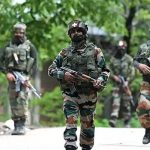Originally published at https://www.firstpost.com/opinion/can-pakistan-afford-a-war-amid-an-economic-crisis-13885337.html
Within 24 hours of India’s action on the Indus Water Treaty after the Pahalgam massacre, Pakistan scrambled to mount a counter-narrative. On April 24, Pakistani Prime Minister Shehbaz Sharif convened the National Security Committee, where India’s actions were called an act of war.
Pakistan declared the Simla Accord void and closed its airspace to India. The rhetoric is fiery, but beneath it lie unmistakable signs of deeper panic.
Diminishing Military Standing
These signs were immediately apparent just days later. After PM Modi granted the Armed Forces a “free hand” to respond to the Pahalgam massacre, Pakistan began bracing for a military strike within the next 24 to 36 hours. At 2 AM on April 30, its information minister claimed “credible intelligence” of imminent Indian action at an emergency press conference. Rawalpindi’s narrative is one of readiness and capability to match any Indian offensive. The Pakistani Senate had just days earlier unanimously rejected India’s accusations, invoking the 2019 Balakot standoff as proof of its ability to defend “sovereignty and territorial integrity”. Behind the bravado, the state of Pakistan’s military tells a more fractured story.
Reports suggest that General Munir’s leadership is being questioned from within the ranks. His speech at the Pakistani Overseas Convention, referring to Kashmir as Pakistan’s “jugular vein”, backfired. Open letters demanding Munir’s resignation, which accuse him of turning the Pakistan Army into “a firing squad for personal vendetta”, are going viral.
Reports emerged of widespread discontent among personnel, particularly in regions like Balochistan where military operations have already left reputations bruised. A reported wave of resignations—250 officers and 1,200 enlisted personnel— is fuelling talk of a brewing mutiny.
Despite unconfirmed numbers, ISPR responded with an internal advisory urging all personnel to maintain morale and reaffirm loyalty to the state. Hashtags like #MunirOut trended on social media as the rumour mill suggested Munir had gone into hiding, fled the country with his family or retreated to a nuclear bunker. These claims remain unsubstantiated, but, in a country where the army is seen as the ultimate authority, the mere suggestion of the chief’s absence during a national security crisis is destabilising.
The unpopularity of Munir had been brewing well before the current crisis, notably during the 2024 elections when his decision to arrest Imran Khan triggered violent protests from Khan’s supporters. This was followed by the controversial detention of senior officers, including Lt Gen Faiz Hamid–Khan’s close ally and former ISI chief–and, days later, the arrest of three more retired officers for “actions prejudicial to military discipline”. These moves intensified perceptions of internal dissent and further fuelled public anger against Munir.
Crisis Diplomacy and International Reactions
The most telling instance of Pakistan facing a policy crisis is the recent shift in stance. On 26 April, at the passing-out parade of the Pakistan Military Academy in Khyber-Pakhtunkhwa’s Kakul, PM Sharif appealed for an “independent” and “credible” probe.
Defence Minister Khawaja Asif suggested that an international team including Chinese, Russian, and Western experts be assembled to “verify whether Mr Modi is lying or telling the truth.” As expected, China was quick to echo Islamabad’s demand by publicly supporting an “impartial investigation” into India’s claims and issued a statement which stressed mutual restraint and reinforced support for Pakistan’s “firm counter-terrorism actions”.
Following China, Dar went on a diplomatic dial-a-thon–calling counterparts in the UK, Iran, Saudi Arabia, Egypt, and Türkiye. PM Sharif also phoned the Iranian president, reportedly inviting Tehran as a mediator between India and Pakistan. Now, in a press conference on April 30, FM Ishaq Dar has said, “No other country has sacrificed as much as Pakistan, nor suffered so much due to terrorism… We have been working closely with the international community to address this common threat.”
Further disproving Pakistan’s innocence was an astonishing admission from Defence Minister Khawaja Asif himself. When asked about Pakistan’s record of training and funding terror outfits, he replied, “We have been doing this dirty work for the US for the past three decades.” The statement came as India, calling Pakistan a “rogue state”, urged global partners to take serious note of Pakistan’s consistent sponsorship of cross-border terrorism.
Meanwhile, following a DG ISPR presser–delivered to a sparse gathering of foreign reporters–General Ahmed Sharif Chaudhry levelled some of the most outrageous and unsubstantiated accusations against India. By showcasing “irrefutable evidence”, he alleged that India was directing cross-border attacks, supplying explosives, and orchestrating strikes on civilians and security personnel–a narrative that came across less as an intelligence briefing and more as political theatre.
General Asim Munir, for his part, has maintained a distinctly combative position. During a visit on May 1 to the Tilla Field Firing Ranges (TFFR) to observe ‘Exercise Hammer Strike’ by the Mangal Strike Corps, he declared, “Let there be no ambiguity–any military misadventure by India will be met with a swift, resolute, and notch-up response.”
Praising the troops’ morale and combat readiness, Munir described them as the “embodiment of the Pakistan Army’s operational excellence”. It also appears that DG ISI Muhammad Asim Malik’s dual appointment as the new National Security Adviser (NSA) on May 01 is a probe towards quiet outreach with India.
What this points to is a deep mismatch within the highest levels of Pakistan’s civilian and military leadership, where erratic posturing betrays a command structure struggling to maintain a unified front in the face of deepening crises. Despite official denials and attempts at deflection, the emerging pattern is difficult to dismiss.
From rushed diplomatic calls to questionable military exchanges, Pakistan’s behaviour suggests a regime scrambling to contain fallout rather than one seeking real accountability.
As India consolidates global support with an assertive narrative, Pakistan’s response appears inconsistent and unconvincing. The old tactics of denial and diversion may no longer shield Islamabad from the growing chorus demanding transparency and action.
A War Pakistan Can’t Afford
While the military is a capable entity in terms of consolidation and power and may also be prepared for confrontation, Pakistan’s brittle economy is in no shape to finance a prolonged standoff–let alone a war.
According to a recent Atlantic Council report, over the last fifty years, Pakistan has slipped from regional potential to one of South Asia’s poorest nations. Chronic fiscal and external deficits have driven up public debt and servicing costs, triggered repeated foreign exchange shortages, and locked the country into a cycle of economic crisis.
Though bilateral and multilateral creditors–who together hold 85 per cent of Pakistan’s external debt–have offered temporary rollovers, the path forward remains precarious. With over $22 billion in repayments due in FY2025, including nearly $13 billion in bilateral deposits, the cushion is rapidly thinning.
Pakistan’s dependence on external lifelines has reached critical levels. It is the fifth-largest debtor to the IMF, which recently extended a $7 billion loan. The World Bank continues to provide targeted support, most recently approving $108 million for programmes in Khyber Pakhtunkhwa. But no institution will underwrite and give money to a country at war.
That leaves China, Pakistan’s largest bilateral lender, with nearly $29 billion on the books. Yet Beijing, too, appears to be tightening its grip on the purse strings. According to the World Bank’s 2024 International Debt Report, China’s share in Pakistan’s total external debt fell to 22 per cent this year, down from 25 per cent in 2023.
The Export-Import (Exim) Bank of China has shown reluctance to extend further concessional loans, citing repayment risks. Islamabad’s February 2025 request to reschedule $3.4 billion in debt, as well as its recent appeal to expand the existing 30 billion yuan swap line by another 10 billion, remain unmet. Previous similar requests were quietly declined. Even more telling is Beijing’s silence.
China has strategic stakes in Pakistan through the China-Pakistan Economic Corridor (CPEC), yet its recent caution signals a recalibration. In the event of war, CPEC infrastructure would be imperilled. Beijing has little appetite to watch its investments go up in smoke.
So who will fund this war? The truth is: no one. Pakistan’s military may prepare for war—but its economy is signalling collapse. A state cannot sustain conflict on the strength of power projection alone. It needs credit, credibility, and currency. Today, Pakistan has precious little of any. And as its generals draw battle lines, its financial institutions are quietly drawing red lines. In the end, the real question may not be whether Pakistan can fight—but whether it can afford to.













